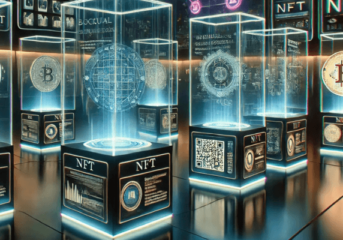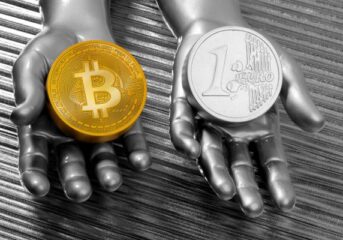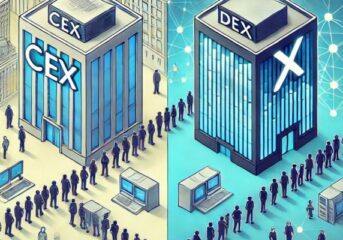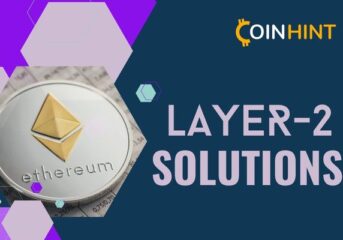What Is a DeFi Platform and How Do They Work?
The world of decentralized finance (DeFi) is intriguing. It promises to revolutionize the financial system, giving people a new way to operate their finances without the need for banks. In just a few short years, the industry has made leaps and bounds in the financial services it offers. Let’s take a journey through this vibrant ecosystem of DeFi platforms to understand how they work so everyone can participate in earning, lending, and borrowing without the need for a central bank.
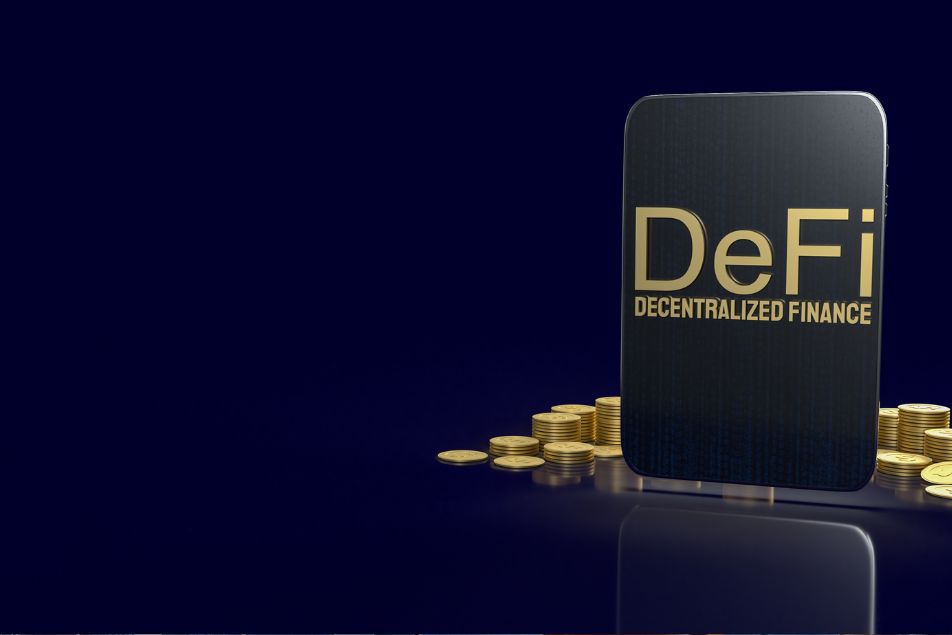
What Is Decentralized Finance (DeFi)?
Definition of DeFi
Decentralized finance, or ‘DeFi,’ is a peer-to-peer financial system that uses blockchain and cryptocurrency to transact freely without a middleman like a bank.
DeFi allows you to do everything you might usually do with a traditional finance institution, such as borrow, lend, earn interest, and trade, among others. You might be wondering what the point of DeFi is, then. Well, it’s faster and requires no paperwork or the trust of a third party. Anyone with a phone and internet connection can transact directly with one another. It’s open to all.
History and Evolution of DeFi
DeFi’s origins are firmly rooted in cryptocurrency and blockchain technology. Bitcoin was launched in 2009, and its primary functions were limited to just sending and receiving Bitcoin tokens. It wasn’t until the launch of Ethereum in 2015 that DeFi caught traction.
Blockchains, like Ethereum, use smart contracts to facilitate complex financial transactions and decentralized applications (dApps). The next milestone was the creation of MakerDAO in 2017. This introduced the decentralized stablecoins and the ability for peer-to-peer lending.
Since this moment, the industry has been booming, with hundreds of platforms and applications being developed.
Understanding DeFi Platforms
What Is a DeFi Platform?
A DeFi platform is a blockchain-based system that operates decentralized financial services. It runs using a set of predetermined rules known as a protocol, which governs how automated smart contracts execute financial procedures.
Automating platforms using smart contracts enables them to run without a central authority. So, two parties can enter into a smart contract for lending, borrowing, trading, and more.
Key Components of a DeFi Platform
Smart Contracts
Smart contracts are digital contracts that automatically self-execute when predefined conditions and terms are fulfilled. Everything is directly written into the code to enforce and execute agreements between two parties.
Decentralized Applications (dApps)
Decentralized applications, or ‘dApps,’ are applications running on blockchain networks. They are automated using smart contracts and have user interfaces for interacting with the blockchain.
Liquidity Pools
Liquidity pools are funds locked into smart contracts to provide capital for financial services. They are key components in decentralized exchanges (DEX), allowing traders to easily swap assets. For lending, they provide a pool of funds for people to borrow from.
How Do DeFi Platforms Work?
The Role of Blockchain in DeFi
Blockchains like Ethereum are the underlying network technology for DeFi operations. These networks have several significant advantages as they are decentralized distributed ledgers. That means all parties using a blockchain can have an identical copy of all transactions. It can never be deleted or edited, making it a secure way to transact – free from fraudulent transactions.
As blockchains can be distributed to anyone, there is no need for middlemen to manage the system. Everything is verified and recorded by the participants in the network. As they are a peer-to-peer network, there’s no need to trust your money to a third party. All of these factors make it perfect for DeFi.
The Process of Using DeFi Platforms
To use DeFi platforms you need to use a cryptocurrency wallet to connect to the platform. This wallet holds your funds and allows you to interact with platforms and blockchains.
Once connected to a DeFi platform, you can instantly start using its financial services to borrow, lend, trade, and earn interest on your crypto. Without realizing it, you’ll quickly be using and executing smart contracts, all recorded onto the underlying blockchain.
There is no need for paperwork, identity verification, or application processes—anyone can use a DeFi platform.
Earning and Investing Using DeFi Platforms
The most loved feature is the ability to earn and invest on DeFi platforms. Instead of just holding or trading crypto, you can now enjoy a deeper ecosystem.
Several platforms enable you to lend assets to a liquidity pool and reward you with interest. Yield farming and crypto staking are highly popular for earning rewards on your funds for being a participant in blockchain networks. Often, the interest offered can be much higher than you’ll find with traditional finance – even 20%, 30%, 40%, and more!
Security and Risks in DeFi
There are inherent risks when engaging with DeFi. As there’s no central figure or bank, when things go wrong there is no one to complain to or provide compensation. Plus, government regulation doesn’t offer the same cover as it does with traditional finance. So, losses are unrecoverable.
Smart contract vulnerabilities, hacks, and market volatility add to the risk. It’s important to do thorough research on a platform and be cautious with new protocols until they have been thoroughly vetted and tested.
How Can I Get Started with Defi?
To start with DeFi, you should learn the basics of blockchain and cryptocurrency. Get yourself a reputable crypto wallet such as Metamask or Ledger. Then, buy a small amount of cryptocurrency from a trustworthy cryptocurrency exchange like Coinbase. Now, you can learn how to transact and use cryptocurrency.
Once you’re confident in the basics, you can begin with small investments and trades on the most robust DeFi services, such as Uniswap, MakerDAO, and Aave. This will allow you to exchange cryptocurrencies, lend, and earn interest on your funds.
Benefits of DeFi Platforms
Accessibility
DeFi platforms are accessible to anyone, anywhere, 24/7. All you need is an internet connection and a phone or computer to participate in the DeFi ecosystem. Unlike the traditional finance system, there are no geographical or wealth barriers to entry.
Control
The control over your finances is unparalleled. You keep 100% custody over your assets without needing to trust a third party like a bank. This removes any reliance on others and near instant execution of transactions. No government or bank can freeze or dictate how you invest funds.
Innovation
Combinability of protocols creates almost unlimited innovation. New financial instruments and investments are constantly being developed. Adding to this, the industry is quick to react to problems it runs into with solutions like liquid staking to combat funds being locked in smart contracts.
ROI
The return on investment is often unbelievable compared to traditional finance. In a world where 5% is thought of as a good return, the 10%, 20%, or even 50%+ returns on DeFi investments are eye-opening.
Transparency
DeFi and blockchain users can track all transactions and smart contracts executing in the ecosystem. This means anyone can audit the platforms to help reduce fraud, crime, or problems. You can’t hide or add fraudulent crypto coins to the system without it being flagged.
Challenges of DeFi Platforms
Volatility
The reliance on cryptocurrencies makes it a highly volatile space. A drop in coin market prices can easily cancel out high yields. It can make lending and borrowing tricky as collateral might quickly reduce in value leaving one party more exposed in the transaction.
Lack of Regulation
Traditional financial regulations don’t fully cover the DeFi world, which exposes risk, especially as cryptocurrencies don’t enjoy the same consumer protections as traditional investments. Many DeFi platforms sit in legal grey areas—while not strictly illegal, they are too innovative to have a definitive place within financial legislation. This could leave investors in a tricky spot if regulations move against them.
Scams and Hacks
Blockchains are highly secure, but crypto wallets and smart contracts still have security flaws exposed by hackers. Scams also commonly target inexperienced users who don’t understand the technology and are attracted to fake returns to get rich quickly.
Full Responsibility
Removing a middleman like a bank and handing control back to individuals comes with responsibility. Individuals are responsible for their security and keeping up with their financial commitments. There’s no one else to call or blame if things go wrong.
The Future of DeFi
The DeFi industry continues to evolve quickly. The first phase of development was a huge step in blockchain innovation, but it does have some problems.
Sustainable liquidity has been a challenge for new platforms to grow. Platforms need people to provide funds for liquidity and enough users to transact to generate fees. These fees then reward liquidity providers. It’s a chicken-and-egg situation. This sort of problem has led to what’s called DeFi 2.0. Second-layer protocols are built on top of the first generation. This brings increased innovation to the space through interoperability, advanced yield farming, and staking mechanisms.
Here, at Coinhint.com, we’re cautiously optimistic about DeFi’s future. Integration with traditional finance systems is still being developed, but crucial steps are slowly occurring. Governments continue to improve regulations, define asset classes, and accept financial products like crypto ETFs.
Conclusion
DeFi is building a new financial system that’s open to everyone. It aims to bring control back to the people rather than the power of a centralized organization, so it’s no surprise it’s building a strong community. While it has been an incredible rise so far, DeFi is still very much in a developmental stage with challenges to overcome. For individuals keen to get started with DeFi, it offers a new way to build wealth and participate in the financial system.
FAQ
-
What are the most popular DeFi platforms?
The most popular DeFi platforms include Uniswap, MakerDAO, Aave, and Lido. They all have billions of dollars in value locked to their platforms.
-
What is the difference between DeFi and traditional finance?
DeFi operates using a peer-to-peer model utilizing a blockchain to execute financial transactions. Traditional finance uses a centralized model where a third party, like a bank, holds funds and executes transactions on behalf of other people.
-
What is a DeFi banking platform?
A DeFi banking platform is a decentralized financial service using cryptocurrency and blockchains to execute financial processes like lending, borrowing, trading, and earning interest on funds – all without the need for a bank.
-
What is an example of DeFi?
An example of DeFi is a decentralized exchange (DEX), which allows people to trade cryptocurrencies directly with one another without the need for a centralized exchange, bank, or company to facilitate the swap.
-
What is the difference between a centralized and a decentralized exchange?
A centralized exchange is operated by a company that acts as a middleman – holding funds and facilitating crypto trades. Decentralized exchanges enable people to trade assets in a peer-to-peer manner directly with one another.



